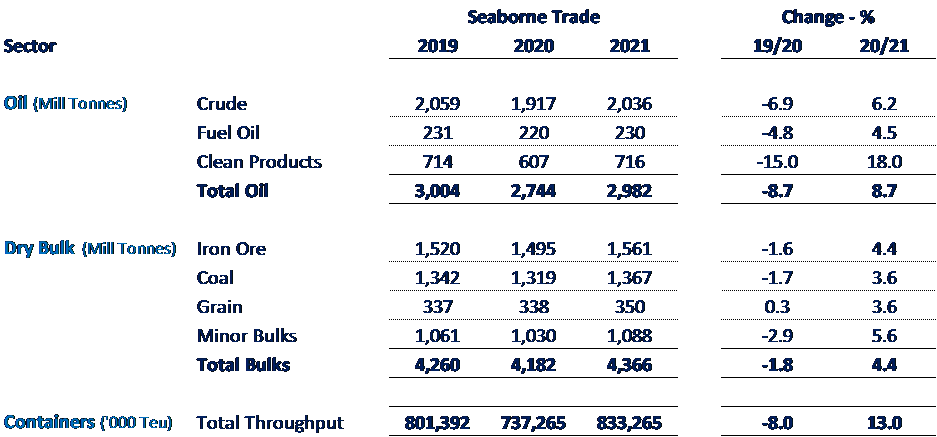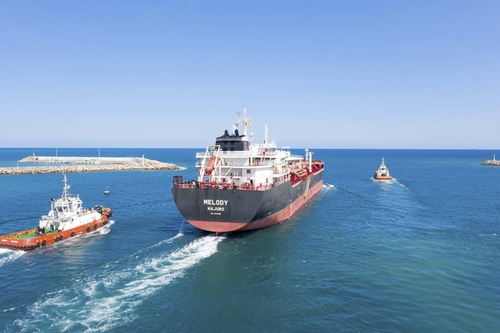By Nigel Gardiner, Group Managing Director of Drewry Shipping Consultants Ltd
The most recent forecast from the International Monetary Fund (IMF) points to a 3 percent contraction in the global economy in 2020 as a result of COVID-19, followed by a 5.8 percent rebound in 2021. The projection assumes that the pandemic will be contained in most countries during the second quarter and recede in the second half of 2020. Nevertheless, despite the anticipated bounce-back in 2021 the cumulative two-year loss to global GDP is estimated to be approximately 9 trillion U.S. dollars and this loss of growth will have severe implications for international shipping markets as the following figures suggest.
Seaborne Trade Outlook

Source: Drewry
Containers
In the container sector, most if not all, regions will face reduced container volumes in 2020 as a direct consequence of COVID-19, but those with greater connectivity to advanced economies will suffer disproportionally. Overall, global container throughput is forecast to decline by 8.0 percent in 2020, before growing by 13.0 percent in 2021.
However, the strength of the recovery will largely depend on how far the economic rescue measures go and the extent that they can maintain business and consumer confidence, something that will inevitably come under strain if the virus pandemic prevails. But for now governments around the world are slowly starting to relax lockdown measures, although at this point in time it is not known the extent to which everyday life and business activity will be changed.
Inevitably COVID-19 has caused immediate disruption to container shipping and the wider supply chain and it remains to be seen what the longer-term impacts will be. The short-term reaction by carriers to sudden production and demand outages around the world has been widespread capacity reductions in the form of blank sailings, which have helped prop up freight rates. But there have also been knock-on equipment availability issues, congestion and slower turnarounds at terminals and warehousing capacity shortages.
In a longer term, there are questions about what the supply chain of the future will look like, as the pandemic has exposed some of the frailties of long-distance supply chains. It seems likely that the move towards more diverse sourcing that was already evident during the tariff disputes will accelerate.
Sectors of Shipping - Now at Different Points in the Cycle

Source: Drewry
Oil Tankers
Under normal circumstances, freight rates in the tanker market move in tandem with oil demand. Therefore, weak oil demand usually leads to lower refinery runs and weak oil trade, which in turn translates into lower freight rates. But COVID-19 has turned tanker market fundamentals upside down, as rates have surged higher when oil demand and oil prices are at record lows.
In the International Energy Agency's (IEA's) latest and worst case forecast global oil demand will fall about 23 mbpd year on year in the second quarter of 2020 and 9.3 mbpd in 2020, with demand for jet fuel, gasoline and diesel being the worst hit markets. Despite the decline in oil demand, oil producers have kept pumping oil at full output which in turn has led to an oil glut of some 30 mbpd that has overwhelmed global onshore storage capacity and led to a steep contango in oil prices. As a result there has been a sudden and sharp rise in oil tankers being used for floating oil storage.
As oil demand is expected to recover gradually in the second half of 2020 with easing COVID-19-enforced lockdowns, oil stored on vessels will be the first to come out of storage. Most of the incremental vessels currently locked in floating storage are therefore expected to return to trade by the end of 2020, which in conjunction with the expansion in fleet will inflate vessel supply in the market.
Although there is still huge uncertainty, oil demand is forecast to rebound in 2021 to the levels seen in 2019 with the improvement in global economic activity and an increase in road transportation and air travel. However, global crude oil trade will still be well below 2019 levels because of the overhang in crude and refined products inventory from 2020.
Overall, the demand-freight equation is likely to remain inversely proportional until 2021, that is, with a gradual recovery in oil demand in the second half of 2020 and 2021, crude tanker rates will go down. However, the pace of recovery in oil demand will decide how quickly or slowly the freight rates will decline.
The turmoil caused by the virus spread may also alter crude oil trading patterns. Before COVID-19, U.S. crude oil was expected to contribute most of the growth in global trade in 2020 and 2021. However, the pandemic has proved to be a major game changer for U.S. shale oil producers as depressed oil prices will not only hurt the U.S. crude exports in 2020, but the steep cut in upstream investment will keep the country's exports depressed in 2021. This will have negative impact on tonne-mile demand for tankers.
Dry Bulk
COVID-19 has also had a severe impact on the dry bulk market. Reduced economic activity has adversely affected both the demand and supply of dry bulk commodities and as a result seaborne trade in dry bulk commodities is forecast to decline by 1.8 percent in 2020, before rebounding by 4.4 percent in 2021.
Steel production, a major driver of the dry bulk shipping market, has plummeted in 2020 owing to a slump in manufacturing and construction activities. This in turn has reduced trade in iron ore and coking coal. Many car manufacturers across Europe have halted production making the second quarter of 2020 one of the worst quarters in recent memory. Low industrial activity has also aggravated the situation for non-coking coal as traders are finding it difficult to sell non-coking coal to Europe with the region swiftly shifting towards renewable energy. However, simultaneously rising imports of coking coal in Asia are supporting overall trade, but low economic growth will dent the demand for coal even in Asia.
In China, renewed economic growth has started to provide some respite to shipowners. Steel production and iron ore imports are growing once more and the steel stockpiles which had risen in the early first quarter of 2020 during the height of the pandemic have started to recede at Chinese steel mills. If global economic activity bounces back by the end of 2020 as expected, freight rates for dry bulk carriers will start to recover in 2021. But although a comparatively low orderbook and the scarce availability of finance for newbuilding will constrain short-term fleet growth, increases in supply ingrowth will still outpace changes in demand and any gains in freight rates are likely to be modest.




 A single purchase
A single purchase









